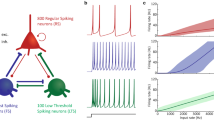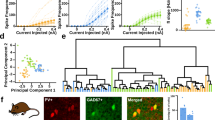Abstract
Spiking neural network models that have studied how oscillations are generated by recurrent cortical circuits and how they encode information have been focused on describing the encoding of information about external sensory stimuli carried by feed-forward inputs in a two-population circuit configuration that includes excitatory cells and fast-spiking interneurons. Here we extend these models to explore the contribution of different classes of cortical interneurons to cortical oscillations. We found that in our extended model, the feed-forward stimulus is still mainly encoded in the gamma frequency range, consistent with earlier works using a single interneuron type. However, we also found that the information carried by different regions of the gamma frequency range was larger than the sum of the information carried by the two individual frequencies. This shows that the power values at different frequencies carried information about the feedforward input in a synergistic way. This is in contrast to previous models with only one interneuron type, which mainly led to redundant information between frequencies in the gamma range. These results suggest that interneuron diversity has useful properties for enriching the encoding of information in the gamma frequency range.
Access this chapter
Tax calculation will be finalised at checkout
Purchases are for personal use only
Similar content being viewed by others
References
Adesnik, H., Bruns, W., Taniguchi, H., Huang, Z.J., Scanziani, M.: A neural circuit for spatial summation in visual cortex. Nature 490(7419), 226–231 (2012)
Angelucci, A., Bijanzadeh, M., Nurminen, L., Federer, F., Merlin, S., Bressloff, P.C.: Circuits and Mechanisms for Surround Modulation in Visual Cortex. Annu. Rev. Neurosci. 40(1), 425–451 (2017)
Barbieri, F., Mazzoni, A., Logothetis, N.K., Panzeri, S., Brunel, N.: Stimulus dependence of local field potential spectra: experiment versus theory. J. Neurosci. 34(44), 14589–14605 (2014)
Belitski, A., et al.: Low-frequency local field potentials and spikes in primary visual cortex convey independent visual information. J. Neurosci. 28(22), 5696–5709 (2008)
Belitski, A., Panzeri, S., Magri, C., Logothetis, N.K., Kayser, C.: Sensory information in local field potentials and spikes from visual and auditory cortices: time scales and frequency bands. J. Comput. Neurosci. 29(3), 533–545 (2010)
Bertschinger, N., Rauh, J., Olbrich, E., Jost, J., Ay, N.: Quantifying unique information. Entropy 16(4), 2161–2183 (2014)
Brette, R., Gerstner, W.: Adaptive exponential integrate-and-fire model as an effective description of neuronal activity. J. Neurophysiol. 94(5), 3637–3642 (2005)
Brunel, N., Wang, X.J.: What determines the frequency of fast network oscillations with irregular neural discharges? I. Synaptic dynamics and excitation-inhibition balance. J. Neurophysiol. 90(1), 415–430 (2003)
Buzsáky, G., Anastassiou, C.A., Koch, C.: The origin of extracellular fields and currents – EEG, ECoG, LFP and spikes. Nat. Rev. Neurosci. 13(6), 407–420 (2012)
Buzsáky, G., Draguhn, A.: Neuronal oscillations in cortical networks. Science 304(5679), 1926–1929 (2004)
Cardin, J.A., et al.: Driving fast-spiking cells induces gamma rhythm and controls sensory responses. Nature 459(7247), 663–667 (2009)
Cavallari, S., Panzeri, S., Mazzoni, A.: Comparison of the dynamics of neural interactions between current-based and conductance-based integrate-and-fire recurrent networks. Front. Neural Circ. 8, 12 (2014)
Cover, T.M., Thomas, J.A.: Information theory and statistics. Elements Inf. Theory 1(1), 279–335 (1991)
DeFelipe, J., et al.: New insights into the classification and nomenclature of cortical GABAergic interneurons. Nat. Rev. Neurosci. 14(3), 202–216 (2013)
Descalzo, V.F., Nowak, L.G., Brumberg, J.C., McCormick, D.A., Sanchez-Vives, M.V.: Slow adaptation in fast-spiking neurons of visual cortex. J. Neurophysiol. 93(2), 1111–1118 (2005)
Einevoll, G.T., Kayser, C., Logothetis, N.K., Panzeri, S.: Modelling and analysis of local field potentials for studying the function of cortical circuits. Nat. Rev. Neurosci. 14(11), 770–785 (2013)
Gewaltig, M.O., Diesmann, M.: NEST (NEural simulation tool). Scholarpedia 2(4), 1430 (2007)
Henrie, J.A., Shapley, R.: LFP power spectra in V1 cortex: the graded effect of stimulus contrast. J. Neurophysiol. 94(1), 479–490 (2005)
Kayser, C., König, P.: Stimulus locking and feature selectivity prevail in complementary frequency ranges of V1 local field potentials. Eur. J. Neurosci. 19(2), 485–489 (2004)
Litwin-Kumar, A., Rosenbaum, R., Doiron, B.: Inhibitory stabilization and visual coding in cortical circuits with multiple interneuron subtypes. J. Neurophysiol. 115(3), 1399–1409 (2016)
Magri, C., Whittingstall, K., Singh, V., Logothetis, N.K., Panzeri, S.: A toolbox for the fast information analysis of multiple-site LFP, EEG and spike train recordings. BMC Neurosci. 10(1), 81 (2009)
Martínez-Cañada, P., Ness, T.V., Einevoll, G.T., Fellin, T., Panzeri, S.: Computation of the electroencephalogram (EEG) from network models of point neurons. PLOS Comput. Biol. 17(4), e1008893 (2021)
Martínez-Cañada, P., Noei, S., Panzeri, S.: Methods for inferring neural circuit interactions and neuromodulation from local field potential and electroencephalogram measures. Brain Inform. 8(1), 27 (2021)
Mazzoni, A., Lindén, H., Cuntz, H., Lansner, A., Panzeri, S., Einevoll, G.T.: Computing the local field potential (LFP) from integrate-and-fire network models. PLOS Comput. Biol. 11(12), e1004584 (2015)
Mazzoni, A., Panzeri, S., Logothetis, N.K., Brunel, N.: Encoding of naturalistic stimuli by local field potential spectra in networks of excitatory and inhibitory neurons. PLoS Comput. Biol. 4(12), e1000239 (2008)
Mitra, P.: Observed Brain Dynamics. Oxford University Press, Oxford (2007)
Panzeri, S., Schultz, S.R., Treves, A., Rolls, E.T.: Correlations and the encoding of information in the nervous system. Proc. R. Soc. London Ser. B: Biol. Sci. 266(1423), 1001–1012 (1999)
Panzeri, S., Senatore, R., Montemurro, M.A., Petersen, R.S.: Correcting for the sampling bias problem in spike train information measures. J. Neurophysiol. 98(3), 1064–1072 (2007)
Panzeri, S., Treves, A.: Analytical estimates of limited sampling biases in different information measures. Netw. Comput. Neural Syst. 7(1), 87 (1996)
Pesaran, B., et al.: Investigating large-scale brain dynamics using field potential recordings: analysis and interpretation. Nat. Neurosci. 21(7), 903–919 (2018)
Pfeffer, C.K., Xue, M., He, M., Huang, Z.J., Scanziani, M.: Inhibition of inhibition in visual cortex: the logic of connections between molecularly distinct interneurons. Nat. Neurosci. 16(8), 1068–1076 (2013)
Pola, G., Thiele, A., Hoffmann, K.P., Panzeri, S.: An exact method to quantify the information transmitted by different mechanisms of correlational coding. Netw. Comput. Neural Syst. 14(1), 35–60 (2003)
Roth, A., van Rossum, M.C.W.: Modeling synapses. In: De Schutter, E. (ed.) Computational Modeling Methods for Neuroscientists. The MIT Press (2009)
Schneidman, E., Bialek, W., Berry, M.J.: Synergy, redundancy, and independence in population codes. J. Neurosci. 23(37), 11539–11553 (2003)
Shannon, C.E.: A mathematical theory of communication. Bell Syst. Tech. J. 27(3), 379–423 (1948)
Urban-Ciecko, J., Barth, A.L.: Somatostatin-expressing neurons in cortical networks. Nat. Rev. Neurosci. 17(7), 401–409 (2016)
Veit, J., Hakim, R., Jadi, M.P., Sejnowski, T.J., Adesnik, H.: Cortical gamma band synchronization through somatostatin interneurons. Nat. Neurosci. 20(7), 951–959 (2017)
Williams, P.L., Beer, R.D.: Nonnegative Decomposition of Multivariate Information. arXiv preprint arXiv:1004.2515 (2010)
Author information
Authors and Affiliations
Corresponding author
Editor information
Editors and Affiliations
Rights and permissions
Copyright information
© 2023 The Author(s), under exclusive license to Springer Nature Switzerland AG
About this paper
Cite this paper
Lorenz, G.M., Martínez-Cañada, P., Panzeri, S. (2023). A Model of the Contribution of Interneuron Diversity to Recurrent Network Oscillation Generation and Information Coding. In: Liu, F., Zhang, Y., Kuai, H., Stephen, E.P., Wang, H. (eds) Brain Informatics. BI 2023. Lecture Notes in Computer Science(), vol 13974. Springer, Cham. https://doi.org/10.1007/978-3-031-43075-6_4
Download citation
DOI: https://doi.org/10.1007/978-3-031-43075-6_4
Published:
Publisher Name: Springer, Cham
Print ISBN: 978-3-031-43074-9
Online ISBN: 978-3-031-43075-6
eBook Packages: Computer ScienceComputer Science (R0)




